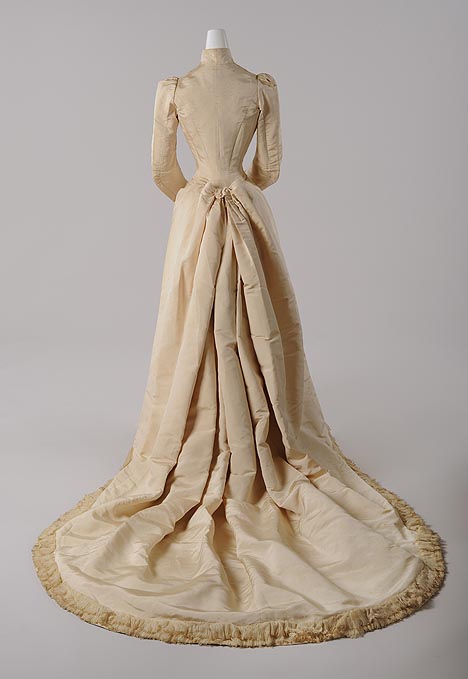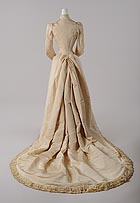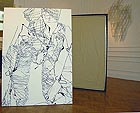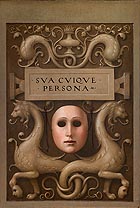
translated and summarized by: Liz Wollner-Grandville,
English summary September 1 - 6
Wien Museum Karlsplatz: Grand Appearance – Fashion during the Ringstraßen era
Always dressed appropriately
There were times when it would have been impossible to dress casually at any time of the day, for any occasion. Sloppy T-shirts and shorts for were absolutely out of the question. That would have been the end of any social career. At the end of the 19th century, in Vienna also known as the Ringstraßen era, a wealthy woman had to change clothes several times a day, whereby colour, material, style, and the accessories offered clear hints where she was heading to. There were morning and afternoon dresses, dresses for family festivities, exhibition openings, taking a ride with the coach, riding, travelling by horse carriage or train, opera and ball robes, and the appropriate robe wear at court.
The exhibit “Grand Appearance – Fashion during the Ringstraßen era, spanning over two floors of the Vienna Museum, offers an enlightening insight into the at times tedious fashion styles which were en-vogue all the way into the 20th century, when women began to wear more sportive clothing. The swimming, tennis, and mountaineering outfits were remarkable. It must have been rather difficult to play a game of tennis in a long skirt or to enjoy a swim with a knitted swimsuit. A wide-brimmed hat with round sunglasses and decorated with a gentian as well as the good old Lederhose are also displayed; and are both still popular today.
Empress Elisabeth’s beautiful robe juxtaposed with the dress of her adversary Katharina Schratt – a bold constellation for both of these fashion icons. Corsets and other kinds of lingerie as well as nightwear are also shown at the exhibition. But one will not find many pieces of clothing of the poor – they wore their clothes as long as they would last, and once they fell apart they served as cleaning cloths.
By Maria-Gabriela Martinkowic
Wien Museum Karlsplatz
1040 Vienna, Karlsplatz, until 01.11.09
www.wienmuseum.at
Museum Villa Stuck: Gerwald Rockenschaub – Promise versus Reality
Gerwald Franz von Rockenschaub
Franz von Stuck must have been an enviable man - especially in his role as the decision-maker among artists at the beginning of the last century. With a magnificent villa in the suburbs of Munich, and an endless coming and going of the representatives of splendour, flamboyance, and pomp encountering those of symbolism and historicism. As well as a selective group of students, handpicked by the artist, among them Paul Klee.
But primarily, to crown his career as a lordly Impresario of art nouveau, with a studio which is capable of positioning sculptures and paintings in the one and only cubic combination-box.
And now, only possible in the Villa Stuck: Gerwald Rockenschaub, the contemporary maestro of elegant hyper-minimalism of the sublime ways of playing/playing fields. Who, at the latest since 1987 and his solo exhibit at the Cologne gallery of Paul Maenz, dared to access the total ensemble and scenario of space and spatiality of art. Reduced to the max! With artistic settings of trans, trance, and cross. Funky and functional. Emotional.
In multimedia Elementarism of the seemingly weightless gesture and light-footed serenity. “Mild and silent?” (Richard Wagner). Not at all. Instead: noble understatement between animation (of the forms) and mediation (among the forms).
On Stuck’s ground-level former sculpture studio (with light coming in from the north) nothing of this vain kitsch can be seen that would correspond to the aesthetic and art-knowledgeable taste of the connoisseurs and their desire from opulence and decadence. As the guest book proves….
But then - quickly up the circular staircase, into the light. Where higher beings in Stuck’s former painting studio might have ordered: withdrawal equals offensive and attack. Where the achievements of the monochrome / monosyllabic painting is sealed into a repressed /dimmed gray. By a wall hanging and in the most neutral tone of colour of all times and all worlds. Murals as (wall) paintings. And the “sound” of the rooms sees itself amused by the sportive stripes of the ornamental ribbons.
Painting today: a sculptural intervention at the loading station of architecture? Or was it the other way around? In any case, Franz von Stuck would have, in the adjacent and now no longer immaculate virgin-room of his daughter, in front of Gerwald Rockenschaub’s reflected object – a veritable tondo, treated himself to a beaker of finest joy with a truant side-glance out the window.
By Stephan Maier
Museum Villa Stuck
81675 Munich, Prinzregentenstr. 60, until 04.10.09
www.villastuck.de
Sotheby’s Vienna: Artist Quarterly: Katharina Schendl – Icebergs
Staging gravity
Katharina Schendl created more of an installation than an exhibition of her work at Stotheby’s. In the middle of the room, three canvas tableaus rest against one another in a fan-shape, while two others lean nonchalantly against the rear walls, ignoring the stucco ledges. This is one part of the play with gravity. The other is found in the works themselves.
Targeted dripping, splashing, pouring, and the flowing-off of color are essential artistic methods implemented instead of brush, spatula, and fingers. Schendl discovered her own method of exposing liquid color media to gravity. A specific motif is not in the foreground, rather the replica of structure; her paintings are clotted structure. Influenced by the surfaces of icebergs – crystalline, bizarre, the artist created stylized enlargements of these structures in grid-like models. The canvas, which was spread over these structures, features the corresponding heights and depths of a hilly landscape. Here Schendl applies an abundance of black as well as white China ink, each finding its own shortest path to the lowest point on the canvas, similar to a drop of water on a rain-wet window pane. The China ink has an astringent effect and creates furrows on the canvas. Detached from the model and spanned into a metal frame, the canvas is forced into a two-dimensional plane, but the three dimensional is preserved. The extensive and partly lazed working-over in a white-gray-black scale allows the flow trail to shine through in the sidelight. And lastly, the open view of the backside of the “life-size” paintings emphasizes the acknowledgement towards the set up, towards the background, towards the supporting structure. One of these grid objects is applied “weightlessly” on the wall – practically paraded.
By Aurelia Jurtschitsch
Sotheby’s Vienna
1010 Vienna, Herrengasse 5, until 10.09.09
www.sothebys.com
Museum für Völkerkunde: We are MASK
Far more than carnival
The exhibition at the Vienna Museum of Ethnology pursues man’s never ceasing quest of his own self and the different roles that we all (must) play in our life – either voluntarily or to meet others’ expectations.
Ridolfo del Ghirlandaio’s portrait cover from the Uffizi in Florence magically attracts the onlooker. It depicts a mask whose ribbons are held by two grotesques who in turn each brace themselves on yet another mask; the inscription “Sua cuique persona” – “Each his own mask” in the middle. This verdict is programmatic for the exhibition and was originally intended as the exhibition title, but made way for the simpler “We are Mask”.
The visitor can hold a copy of this mask in front of his face while walking through the exhibition, and if one does this throughout the entire presentation, there is a surprise in store: one’s mirror image reveals one’s “own” personal “mask” – or “true” face.
There are seven stages between the Florentine original and one’s own mirrored-mask image. The works, associatively arranged by Sylvia Ferino-Pagden’s team, lead to amusing and surprising combinations. Karl V’s Medusa shield and diverse tournament helmets are found in immediate proximity with a film requisite: Darth Vader’s helmet from Star Wars. And beautifully embroidered full size veils of Afghan women are also displayed. Are these also masks? Evidently. This exhibition is distinguished through this kind of intellectually- scrutinizing and simultaneously playful approach.
The basis of the exhibit is provided by numerous works from collections in Vienna, from the KHM, the Musems for Ethnology and Theatre, the Albertina, the Vienna Museum, MAK and MUMOK. Among the works are also loans from foreign countries. One of the oldest masks in the world, a stone mask from Paris, was created around 7000 BC, others come from Rome such as Bernini’s “Medusa” or the “Infant Dionysus with mask”, as well as paintings by Poussin, Guardi, G.D. Tiepolo, Longhi and Lippi (see the exhibition poster). Fashion designer Capucci’s mask dress “The Jewellery Woman” masks by Sartori and Stiefel, video art (Orlan), Picasso’s “Great Snow Owl” as well as Daniel Spoerri’s “Mask Yoke” are examples of recent works.
This exhibition proves that masks, despite their diverse origin and purpose, have a joining theme throughout all cultures and all along have met mankind’s basic needs.
By Maria-Gabriela Martinkowic
Museum für Völkerkunde
1010 Vienna, Neue Burg, until 28.09.09
www.ethno-museum.ac.at
Mehr Texte von translated and summarized by: Liz Wollner-Grandville


 Teilen
Teilen





